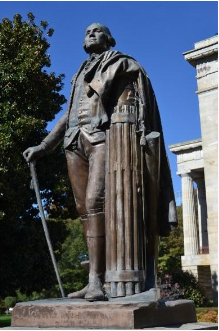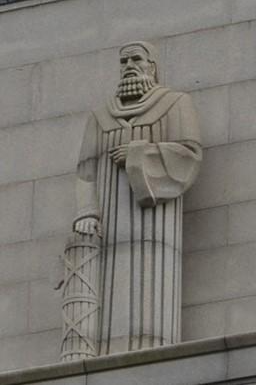Visual Reminders of North Carolina’s Classical Heritage
 North Carolina’s Capitol Building, located on Capitol Square in downtown Raleigh, is considered a premier example of Greek Revival architecture. A fire destroyed the state’s first State House at the Capitol Square location in June 1831. The present structure was completed in 1840 and contained the offices of North Carolina's state government until 1888 when the Supreme Court and State Library moved into a separate building. The General Assembly relocated in 1963 to the nearby State Legislative Building on Jones Street. The Governor and other state government staff continue to utilize offices on the Capitol’s first floor.
North Carolina’s Capitol Building, located on Capitol Square in downtown Raleigh, is considered a premier example of Greek Revival architecture. A fire destroyed the state’s first State House at the Capitol Square location in June 1831. The present structure was completed in 1840 and contained the offices of North Carolina's state government until 1888 when the Supreme Court and State Library moved into a separate building. The General Assembly relocated in 1963 to the nearby State Legislative Building on Jones Street. The Governor and other state government staff continue to utilize offices on the Capitol’s first floor.
The Capitol Building features architectural styles and patterns that are representative of Classical Rome and Greece. It has Doric order columns and a dome with an oculus. These architectural motifs are reflective of the ancient Roman Pantheon. The interior of the Capitol building includes columns of the Corinthian order, as well as fluted Ionic columns. This pattern of design imitates the north portico of the Greek Erechtheion.
In addition to architectural motifs, statues at the Capitol Building are also the product of Classical inspiration. Inside the Capitol Building, at the center of the rotunda, sits Antonio Canova’s statue of George Washington, a copy of the original destroyed in the 1831 fire. A Salisbury-based newspaper, the Western Carolinian, noted in 1821 Canova’s linkage of Washington’s life to ancient  Roman culture within the statue; it was made of marble, with Washington “clad in Roman attire” holding a sword in “the shape of an old Roman” sword. The statue captured “four principal events” of Washington’s life: his assuming command of the Continental Army during the American Revolution, his defeat of the British Army at Yorktown in 1781, voluntarily giving up his power of public office, and his retirement to a “private life in the tranquil occupation of a farmer.” The theming of “four principal events” were a reference to the example of the ancient Roman farmer, Lucius Quinctius Cincinnatus; his life was defined by four similar “principal” events: his transition to soldier from farmer, his defense of Rome, his ascent to the dictatorship, and his retirement. An 1824 North-Carolina Free Press (Halifax, NC) review of Canova’s statue wrote similarly, saying that it was among the finest works of “Grecian art,” equivalent in aesthetic to the “Dying Gladiator.” And, if thought inferior, Canova’s depiction of Washington was overshadowed only by “The Apollo Belvedere.”
Roman culture within the statue; it was made of marble, with Washington “clad in Roman attire” holding a sword in “the shape of an old Roman” sword. The statue captured “four principal events” of Washington’s life: his assuming command of the Continental Army during the American Revolution, his defeat of the British Army at Yorktown in 1781, voluntarily giving up his power of public office, and his retirement to a “private life in the tranquil occupation of a farmer.” The theming of “four principal events” were a reference to the example of the ancient Roman farmer, Lucius Quinctius Cincinnatus; his life was defined by four similar “principal” events: his transition to soldier from farmer, his defense of Rome, his ascent to the dictatorship, and his retirement. An 1824 North-Carolina Free Press (Halifax, NC) review of Canova’s statue wrote similarly, saying that it was among the finest works of “Grecian art,” equivalent in aesthetic to the “Dying Gladiator.” And, if thought inferior, Canova’s depiction of Washington was overshadowed only by “The Apollo Belvedere.”
Symbols of the Classical Greco-Roman world like the fasces are also found within Capitol Building architecture. Fasces were the ancient Roman symbol of authority and were composed of a cylindrical bundle of elm wood or birch sticks tied together with an ax blade protruding from the cylinder. Ancient Roman legal and religious officials called lictors carried the fasces. The fasces spanned all periods of ancient Roman history, serving as an outwardly visible, potent symbol of Roman authority. Despite being composed of sticks, leather straps, and an ax, the fasces could be activated to whip, flail, or even behead those resisting Roman authority. For ancient audiences, the fasces inspired fear because they could, and were, employed as mobile punishment devices. 
Outside of the Capitol Building, on its south side, sits Jean-Antoine Houdon’s statue of President George Washington. Houdon’s statue of Washington is one of many copies, cast in bronze, of Houdon’s original marble work which was created in the late 1700s. Houdon’s statue of Washington in Raleigh was dedicated on July 4, 1857. In reporting the unveiling ceremonies, one Raleigh-based newspaper, the Semi-Weekly Standard, wrote: “…we may now point with becoming pride to this statue, as evidencing our respect for the illustrious dead…and then exclaim with the proud spirit of the Roman, I am indeed a North Carolinian.” The statue itself is enclosed with an iron fence that also incorporates the symbol of the fasces as its fence posts.

The fasces and the plow symbolically linked Washington again to the historical example of Cincinnatus, the Roman leader who was given dictatorial powers during a military emergency but chose to forgo them and return to his farm after the threat was nullified. Washington has been compared to Cincinnatus since he too resigned his military commission at the end of the Revolutionary War and chose to serve only two terms as President of the United States.
Across the street from Houdon’s statue is the Justice Building, located between Fayetteville and Wilmington Streets. Completed in 1940, the Justice Building is home to North Carolina’s Supreme Court and was constructed during the Great Depression with federal government assistance via the New Deal’s Public Works Administration (PWA). A 12-ton statue of a robed figure with the Roman fasces beside its right leg can be viewed on a ledge above the Justice Building’s façade.
The intent and desired meaning of the statue of the robed figure garnered attention in 1940. Some were told the figure was Moses while others were informed that it was a lictor, an ancient Roman law enforcement officer; the lictor would use the rods of the fasces to flail scofflaws and, in the most extreme cases, employ the ax to behead criminals. When asked, sculptor Charles B. Warren dispelled the idea that the statue represented Solon, a famous ancient Greek statesman, but maintained that it was a figure representative of the idea of law and justice. But given the punitive legacy of the ancient Roman lictor, the Raleigh News and Observer reported in 1940 that the judges preferred to interpret the statue Biblically, as a Moses figure.
References:
Brennan, T. Corey. The Fasces: A History of Ancient Rome’s Most Dangerous Political Symbol. Oxford University Press: Oxford, England. 2023.
“ History of the Justice Building.” North Carolina Judicial Branch. Accessed February 16, 2023 at https://www.nccourts.gov/courts/supreme-court/history-of-the-justice-bui...
North Carolina State Capitol Foundation. Accessed February 16, 2023 at https://ncstatecapitol.org/property.html
“Remarks on Canova’s Statue of Washington, at Raleigh.” North-Carolina Free Press. Halifax, N.C. July 2, 1824. Accessed February 16, 2023 at https://newspapers.digitalnc.org/lccn/sn92073983/1824-07-02/ed-1/seq-4/
Semi-Weekly Standard. Raleigh, N.C. July 8, 1857. Accessed February 16, 2023 at https://newspapers.digitalnc.org/lccn/sn83045450/1857-07-08/ed-1/seq-1/
“Statue of Washington,” Western Carolinian. Salisbury, N.C. July 17, 1821. Accessed February 16, 2023 at https://newspapers.digitalnc.org/lccn/sn84026486/1821-07-17/ed-1/seq-1/
“The Capitol (Raleigh) WA0007.” National Register Of Historic Places Inventory - Nomination Form. National Park Service, United States Department of the Interior. February 26, 1970. Accessed February 16, 2023 at https://files.nc.gov/ncdcr/nr/WA0007.pdf
The Raleigh Minerva. Raleigh: N.C. December 27, 1816. Accessed February 16, 2023 at https://newspapers.digitalnc.org/lccn/sn83045163/1816-12-27/ed-1/seq-1/
“Under the Dome.” News and Observer. Raleigh, NC. June 17, 1940
“Washington Statue.” National Park Service. September 12, 2022. Accessed February 16, 2023 at https://www.nps.gov/places/washington-statue-vafo.htm
Additional Resources:
State Capitol on NCpedia: https://www.ncpedia.org/state-capitol
Image Credits:
Highsmith, Carol M, photographer. A most unusual statue of the first U.S. president, George Washington, in a toga, in the North Carolina Capitol in Raleigh. Photograph. Raleigh, North Carolina. June 5, 2017. Accessed February 16, 2023 at https://www.loc.gov/item/2017880768/
Highsmith, Carol M, photographer. The North Carolina Capitol in Raleigh, North Carolina. Photograph. Raleigh, North Carolina. June 5, 2017. Accessed February 16, 2023 at https://www.loc.gov/item/2017880644/
16 February 2023 | Hill, Steven